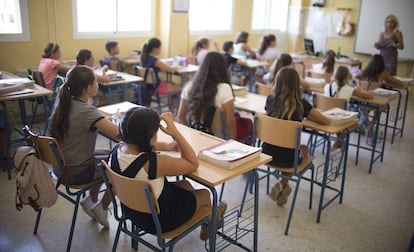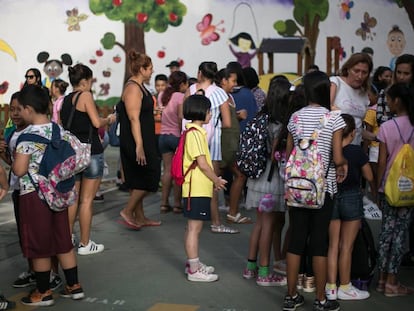Bad education? Why more class time has not improved academic results in Spain
Spanish high school students perform worse on PISA tests than Finnish pupils, even though they spend 246 more hours in the classroom

A student at a Spanish high school receives 1,045 hours of class time a year – 246 more than a Finnish student (808) – but performs worse on average on the Program for International Student Assessment (PISA) test, according to the report Education at a Glance 2019, from the Organisation for Economic Co-operation and Development (OECD).
When countries improve the quality of their teaching, they tend to achieve better results without increasing the learning time
Andreas Schleicher, head of PISA test
The study, which was released on Tuesday, ranks Spain in the middle in terms of academic performance, while Finland is an international leader in secondary school education. Greece is the European country with the fewest hours of class time (791) and has mediocre PISA results. But Sweden, Norway and Japan have similar class hours and are among the best-ranked academically.
Spain has more class time than the EU average (893 hours) and the OECD average (910). The country also has more lessons in language, mathematics and foreign languages than the OECD average. The difference in class time is also evident at the primary school level, but is less pronounced. Spain has 792 hours of class, 23 more than the EU average and nine more than the OECD average.
Andreas Schleicher, the head of PISA Tests, is clear: more class time does not guarantee a better education. “When countries improve the quality of their teaching, they tend to achieve better results without increasing the learning time of the student.” For example, Japanese students study 41 hours a week (28 in the classroom and 14 extracurricular) and Korean students spend 50 hours studying (30 hours in the classroom and 20 extracurricular), but their academic results are very similar.
In Tunisia and the four Chinese provinces where PISA exams are taken, students study for 30 hours in the classroom and 28 outside. But although they spend the same amount of time studying, there is a stark difference in their science results – Tunisia scored 367 points and China 530 points.
What is PISA?
PISA is a test from the OECD that is given every three years to 15-year-old students in both private and public schools from all over the world. The exam tests the students in reading, mathematics and science. Over half a million 15-year-olds from 80 countries and economies took the PISA test in 2018.
Alejandro Tiana, Spain’s education secretary of state, has invited the education community to discuss the allocation of school hours. “We have to reflect about how school time is used in Spain,” he said.
Raimundo de los Reyes, the head of FEDADI, the federation that brings together the leaders of public secondary schools, believes students in Spain study for too many hours – six hours in class plus three or four hours on homework, projects and other school activities. “That is longer than the working day of many employees.”
“I would do away with 10 hours if in exchange we had fewer students in the classroom and could give them more personalized attention. We need resources, more assistant teachers, and to give more time for teachers to prepare all classes, not just the ones in English,” he added.
Maribel Loranca, the head of education at the UGT trade union, agrees class time should be cut, arguing long hours “take away time from attention for families, personal treatment and innovation.”
Meanwhile, PISA experts warn that Spain will not improve its academic performance until students spend more time on finding their own solutions to problems and less on memorizing information.
English version by Melissa Kitson.
Tu suscripción se está usando en otro dispositivo
¿Quieres añadir otro usuario a tu suscripción?
Si continúas leyendo en este dispositivo, no se podrá leer en el otro.
FlechaTu suscripción se está usando en otro dispositivo y solo puedes acceder a EL PAÍS desde un dispositivo a la vez.
Si quieres compartir tu cuenta, cambia tu suscripción a la modalidad Premium, así podrás añadir otro usuario. Cada uno accederá con su propia cuenta de email, lo que os permitirá personalizar vuestra experiencia en EL PAÍS.
¿Tienes una suscripción de empresa? Accede aquí para contratar más cuentas.
En el caso de no saber quién está usando tu cuenta, te recomendamos cambiar tu contraseña aquí.
Si decides continuar compartiendo tu cuenta, este mensaje se mostrará en tu dispositivo y en el de la otra persona que está usando tu cuenta de forma indefinida, afectando a tu experiencia de lectura. Puedes consultar aquí los términos y condiciones de la suscripción digital.
More information
Archived In
Últimas noticias
Most viewed
- Sinaloa Cartel war is taking its toll on Los Chapitos
- Reinhard Genzel, Nobel laureate in physics: ‘One-minute videos will never give you the truth’
- Oona Chaplin: ‘I told James Cameron that I was living in a treehouse and starting a permaculture project with a friend’
- Why the price of coffee has skyrocketed: from Brazilian plantations to specialty coffee houses
- David King, chemist: ‘There are scientists studying how to cool the planet; nobody should stop these experiments from happening’











































